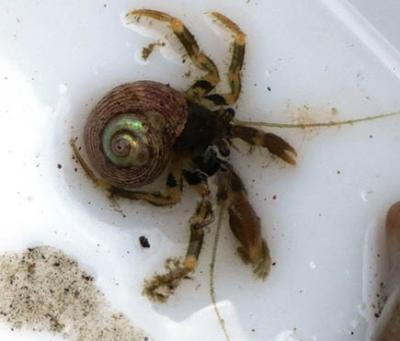
Our Beach Community: Armored Citizens

There is a group of beach residents who neither live with unprotected soft bodies, nor grow tough shells like clams and crabs. This is the group of odd crabs known as the hermits, which have soft, curled, bare abdomens, but also have armored claws and heads. Cindy Young relates that, “Since they have no carapace to protect them from predators like most other crabs do, the Hermit Crab larvae must find empty shells of dead snails to use. As they grow they periodically need to find another larger shell, and some do so by stealing shells from others! When mating, to get the female hermit crab to respond to him the male insistently taps on her shell while he holds the shell and defends it with his large right pincer. After two or three days of this the female finally emerges part of the way from her shell and invites him to attach his packet of sperm around her belly to fertilize the emerging eggs held in her pleopods (small appendages on her abdomen). The eggs are protected inside her borrowed shell until they hatch. Then she releases them into the water where they float as larvae in the plankton.”
Barnacles are the real opposites of the soft anemones, nudibranchs and jellies in terms of how much of themselves is allocated to armor. They are about half composed of white calcareous plates, so they are like tiny forts who, once settled, stay in one place all their lives. As Gail Brooks explains, “Acorn Barnacles, related to shrimp, are little jointed-legged animals hiding their identity in cone-shaped limestone shells made up of six plates fused to each other with a trap door in the ceiling. They begin life as free swimming larvae. When the time comes to settle, the larvae ‘glue’ their heads to hard surfaces, such as pilings, wharves, ships, rocks or even other hard-shelled animals, like crabs. Barnacles spend their lives in this position—head down and feet up. When water covers a barnacle, the trap door opens and the barnacle’s feathery legs emerge to sweep the water for plankton and detritus. Barnacles have no gills, instead absorbing oxygen through their legs.” Legs that double as arms, food providers, and noses are pretty remarkable. Barnacles have really streamlined their approach to meeting their basic needs!
They have also evolved a substance that scientists have yet to be able to duplicate. Gail writes, “Cement glands within the antennae produce the brown glue that fastens a barnacle to a hard surface. Acids and alkalis do not dissolve this incredibly strong glue that can hold the base of the shell to a surface long after the barnacle is dead. Dentists, interested in the adhesive power of this blue, have been trying to determine its properties.”
Does armor provide adequate defense for crabs and barnacles? Not always! “Barnacle predators include snails that drill through the shell, usually at junction points, and seastars that can pull the plates apart and evert their stomachs directly into the opening. Dog whelks can drill into the shells. Even grazing limpets can have a substantial effect on a tiny, newly settled barnacle, which they are able to bulldoze off the substrate.” And barnacles on higher beach locations face additional challenges, including “temperature, dryong out, too much sun, salinity, battering by logs, and access to mating partners. Another source of abrasive damage to barnacles is foot traffic associated with casual beach walkers, students on field trips, and researchers.”
Come to the Low Tide Celebration at Point Robinson on Sunday, June 5, 10am-3pm to meet these residents and more, and hear some of their fascinating stories!
- Login to post comments
